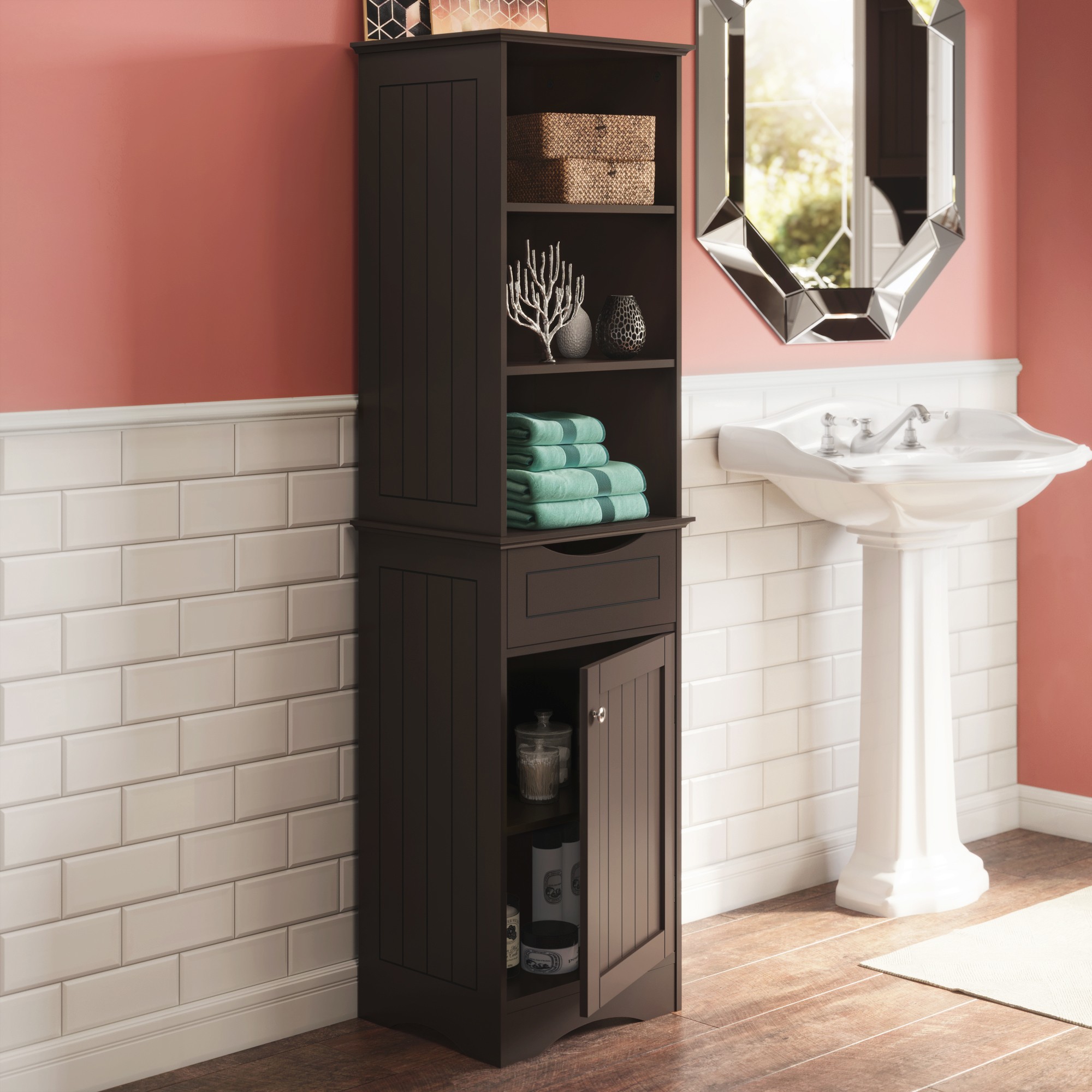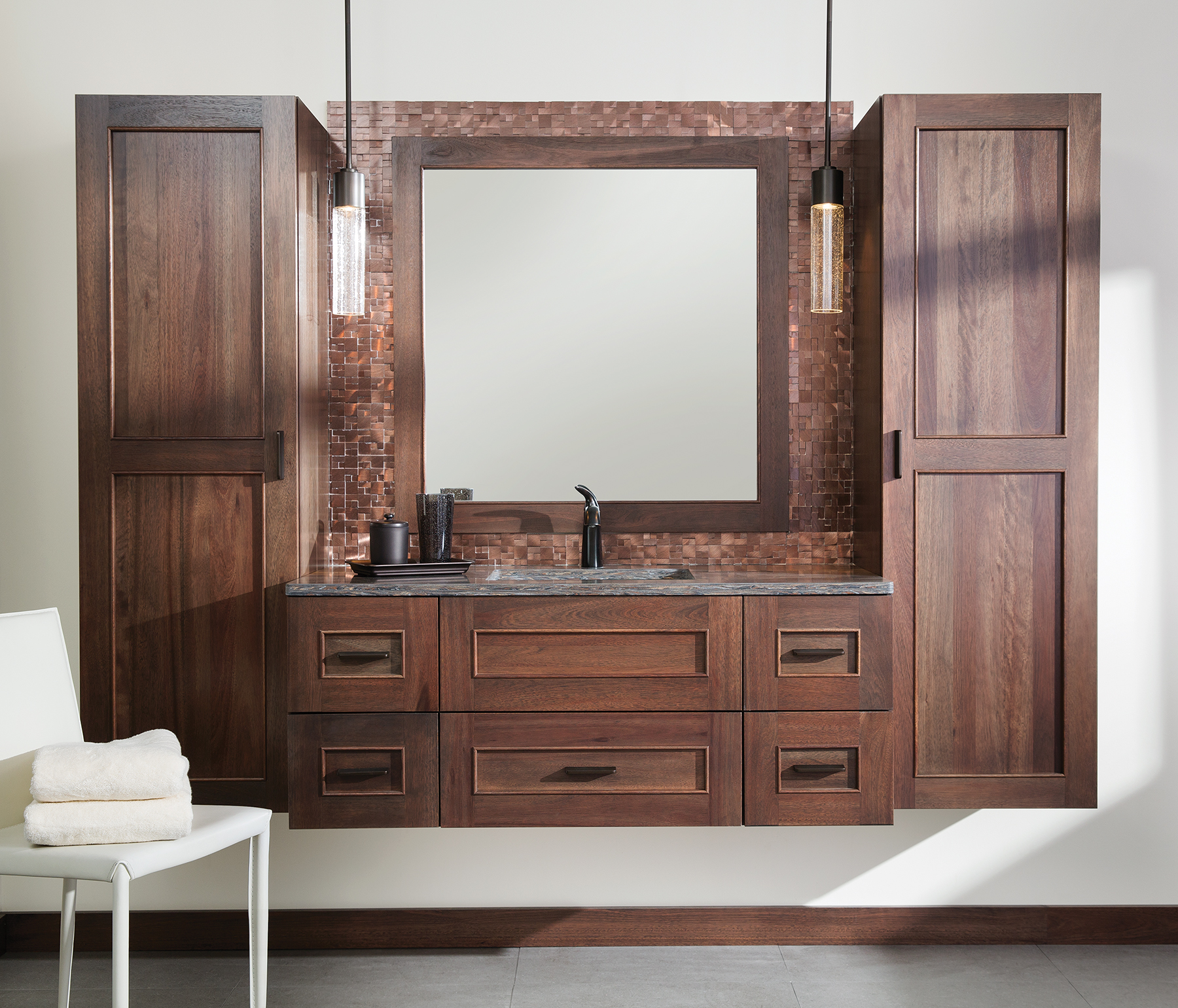Types and Styles of Vanity and Linen Cabinets: Vanity And Linen Cabinets For Bathroom

Bathroom vanities and linen cabinets are essential elements in any bathroom, offering both functionality and style. The vast array of choices available can be overwhelming, but understanding the different types, styles, and features will help you select the perfect pieces to complement your bathroom’s design and meet your storage needs. This section will explore the various options available, from materials and construction to storage solutions and installation types.
Vanity and Linen Cabinet Styles and Materials
The style of your vanity and linen cabinet significantly impacts the overall aesthetic of your bathroom. Choosing the right style depends on your personal preference and the existing décor. The following table details various styles, common materials, and typical finishes.
| Style | Materials | Finishes | Description |
|---|---|---|---|
| Traditional | Solid wood (oak, cherry, mahogany), marble | Satin, gloss, antique | Characterized by ornate details, intricate carvings, and classic silhouettes. Often features raised panels and detailed hardware. |
| Modern | Lacquered wood, glass, metal | High-gloss, matte, metallic | Clean lines, minimalist designs, and sleek surfaces are key features. Often incorporates geometric shapes and bold colors. |
| Farmhouse | Reclaimed wood, distressed wood, metal | Whitewash, natural, distressed | Rustic charm and a sense of warmth are central to this style. Often features distressed finishes, open shelving, and simple hardware. |
| Contemporary | Wood veneer, laminate, acrylic | Neutral tones, bold colors, textured finishes | Blends modern and traditional elements, featuring clean lines and a focus on functionality. Materials are often a mix of natural and man-made. |
Freestanding, Wall-Mounted, and Built-in Vanities and Linen Cabinets
The method of installation significantly impacts both the functionality and visual appeal of your vanity and linen cabinets. Each type offers unique advantages and disadvantages.
Freestanding vanities are self-supporting units that sit on the floor. They offer flexibility in placement and are easily movable. A classic example is a traditional vanity with multiple drawers and a marble countertop. Wall-mounted vanities, on the other hand, are attached directly to the wall, maximizing floor space. They often have a floating appearance and create a modern, airy feel. A sleek, minimalist vanity with integrated sinks exemplifies this style. Built-in vanities are custom-designed to fit a specific space, offering seamless integration with the bathroom’s layout. They are often part of a larger bathroom remodel and provide maximized storage. A custom-built vanity with integrated drawers and shelving perfectly illustrates this. Similarly, linen cabinets can be freestanding, wall-mounted, or built-in, offering the same range of installation options and aesthetic considerations.
Vanity and Linen Cabinet Storage Solutions
Effective storage is paramount in bathroom design. Vanities and linen cabinets offer various storage solutions to accommodate different needs and preferences.
Drawers provide concealed storage and prevent items from being visible. They can be shallow for smaller items like toiletries or deep for towels and linens. The smooth gliding action of high-quality drawer slides enhances usability. Shelves, both open and closed, offer versatile storage options. Open shelves provide easy access to frequently used items, while closed shelves offer concealed storage for less frequently used items. Pull-out trays, often found in vanities, offer easy access to items stored at the back of the cabinet. These trays can be customized to hold specific items, such as makeup or hair styling tools, and enhance organization. A well-designed vanity might incorporate a combination of drawers, shelves, and pull-out trays to maximize storage and organization, offering a practical and aesthetically pleasing solution.
Space Planning and Design Considerations

Careful planning is crucial for maximizing both functionality and aesthetics in a bathroom, particularly when incorporating a vanity and linen cabinet. The size and placement of these key elements significantly impact the overall usability and visual appeal of the space. Consideration must be given to factors like available square footage, plumbing access, electrical outlets, and the desired style to achieve a well-designed and efficient bathroom.
Small Bathroom Layout Design, Vanity and linen cabinets for bathroom
A small bathroom (approximately 5′ x 7′) can effectively accommodate a vanity and linen cabinet with strategic planning. Imagine a layout where a 36″ wide vanity is positioned along one of the shorter walls, leaving ample space for a shower or tub on the opposite wall. The vanity’s countertop extends to create a small landing area. Next to the vanity, a 12″ deep, floor-to-ceiling linen cabinet is integrated, maximizing vertical space. This cabinet could feature narrow shelves for efficient storage of towels and toiletries. The visual effect is a streamlined and functional space. The color palette should be light and bright to enhance the sense of spaciousness, and the use of mirrors will further amplify the perceived size.
Plumbing and Electrical Considerations
Plumbing access and electrical outlets are critical aspects of vanity and linen cabinet placement. Failing to account for these can lead to costly renovations. For instance, positioning a vanity directly over existing plumbing lines may require extensive rerouting, increasing both time and expense. Similarly, placing a linen cabinet where electrical work is needed, such as for lighting or heated towel racks, may necessitate additional wiring, which could involve cutting into walls. Solutions include carefully studying the bathroom’s plumbing and electrical plans before placement, consulting with a plumber and electrician for advice, and, if necessary, adjusting the layout to accommodate existing infrastructure. For example, slightly shifting the vanity position might avoid plumbing conflicts, while strategically positioning outlets in the cabinet’s design can eliminate the need for extra wiring.
Impact of Vanity and Linen Cabinet Size and Style
The size and style of the vanity and linen cabinet significantly impact the overall bathroom aesthetic. A large, ornate vanity in a small bathroom can overwhelm the space, while a small, minimalist vanity might feel lost in a large bathroom. For example, a sleek, modern vanity with a floating design works well in contemporary bathrooms, maximizing space and creating a clean look. Conversely, a traditional vanity with ample storage and detailed woodwork complements classic or farmhouse-style bathrooms, adding a touch of elegance. The linen cabinet should also complement the vanity style; a tall, narrow cabinet suits a modern aesthetic, while a shorter, wider cabinet might be more suitable for a traditional design. Consistency in style and material choices between the vanity and linen cabinet creates a cohesive and visually appealing bathroom.
Materials, Finishes, and Maintenance

Choosing the right materials and finishes for your bathroom vanity and linen cabinets is crucial for both aesthetics and longevity. The materials you select will directly impact the overall look and feel of your bathroom, as well as the ease of maintenance over the years. Careful consideration of durability and practicality alongside your design preferences will ensure a beautiful and functional space.
Vanity and Linen Cabinet Materials: A Comparison
The selection of materials significantly influences the durability and maintenance needs of bathroom vanities and linen cabinets. Each material offers a unique set of advantages and disadvantages.
- Wood: Wood vanities offer a classic, elegant look and can be customized with various stains and finishes. However, they require more maintenance than other materials and are susceptible to water damage if not properly sealed and cared for.
- Pros: Natural beauty, durability (with proper care), customizable finishes, potential for increased value.
- Cons: High cost, requires regular sealing and maintenance, susceptible to water damage and warping without proper protection.
- Laminate: Laminate is a cost-effective and durable option that mimics the look of various materials, including wood and stone. It’s resistant to moisture and scratches, making it a low-maintenance choice.
- Pros: Affordable, durable, moisture-resistant, easy to clean.
- Cons: Can be susceptible to chipping or peeling at edges, less luxurious appearance compared to natural materials, limited design options compared to wood.
- Solid Surface: Solid surface materials, such as Corian, are non-porous and resistant to stains and bacteria, making them ideal for humid bathroom environments. They are also easy to repair if damaged.
- Pros: Non-porous, stain-resistant, seamless appearance, easy to repair.
- Cons: Can be more expensive than laminate, may scratch more easily than some other materials, can be heat-sensitive.
Finish Options for Bathroom Vanities and Linen Cabinets
The finish significantly impacts the overall aesthetic of your bathroom. Different finishes can create a variety of moods, from modern and minimalist to traditional and rustic.
Paint colors offer endless possibilities for customization, allowing you to match your vanity and linen cabinets to your bathroom’s color scheme. For instance, a crisp white finish creates a clean, bright space, while a deep navy blue can add a touch of sophistication. Stains enhance the natural beauty of wood, offering a range of tones from light and airy to rich and dark. Veneers provide a cost-effective way to achieve the look of high-end wood species without the high price tag. A cherry veneer, for example, adds warmth and elegance, while a maple veneer offers a clean, contemporary feel.
Cleaning and Maintaining Vanity and Linen Cabinet Materials
The following table provides a guide to cleaning and maintaining various vanity and linen cabinet materials.
| Material Type | Cleaning Instructions |
|---|---|
| Wood | Dust regularly with a soft cloth. Clean spills immediately with a damp cloth and mild soap. Avoid harsh chemicals and abrasive cleaners. Reapply sealant as needed. |
| Laminate | Wipe clean with a damp cloth and mild soap. Avoid abrasive cleaners and scouring pads. |
| Solid Surface | Clean with a damp cloth and mild soap. Avoid abrasive cleaners and scouring pads. For stubborn stains, use a non-abrasive cleaner specifically designed for solid surface materials. |
